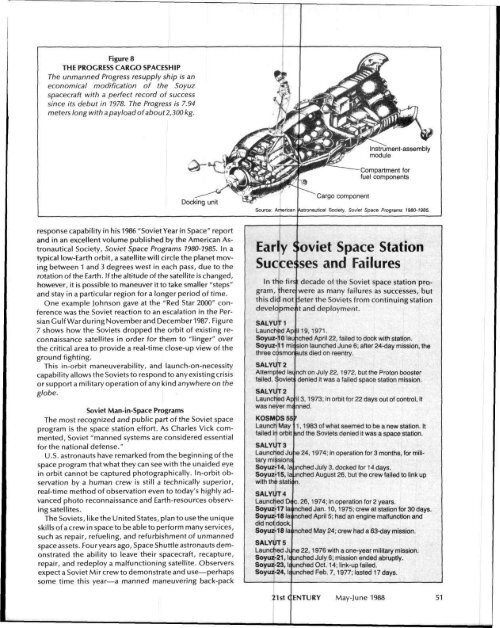The Geometry The Nucleus
The Geometry The Nucleus
The Geometry The Nucleus
You also want an ePaper? Increase the reach of your titles
YUMPU automatically turns print PDFs into web optimized ePapers that Google loves.
Figure 8<br />
THE PROGRESS CARGO SPACESHIP<br />
<strong>The</strong> unmanned Progress resupply ship is an<br />
economical modification of the Soyuz<br />
spacecraft with a perfect record of success<br />
since its debut in 1978. <strong>The</strong> Progress is 7.94<br />
meters long with a pay load of about 2,300 kg.<br />
Instrument-assembly<br />
module<br />
Compartment for<br />
fuel components<br />
Docking unit<br />
Source; American<br />
Cargo component<br />
^stronautical Society, Sower Space Programs 1980-1985.<br />
response capability in his 1986 "Soviet Year in Space" report<br />
and in an excellent volume published by the American Astronautical<br />
Society, Soviet Space Programs 1980-1985. In a<br />
typical low-Earth orbit, a satellite will circle the planet moving<br />
between 1 and 3 degrees west in each pass, due to the<br />
rotation of the Earth. If the altitude of the satellite is changed,<br />
however, it is possible to maneuver it to take smaller "steps"<br />
and stay in a particular region for a longer period of time.<br />
One example Johnson gave at the "Red Star 2000" conference<br />
was the Soviet reaction to an escalation in the Persian<br />
Gulf War during November and December 1987. Figure<br />
7 shows how the Soviets dropped the orbit of existing reconnaissance<br />
satellites in order for them to "linger" over<br />
the critical area to provide a real-time close-up view of the<br />
ground fighting.<br />
This in-orbit maneuverability, and launch-on-necessity<br />
capability allows the Soviets to respond to any existing crisis<br />
or support a military operation of any kind anywhere on the<br />
globe.<br />
Soviet Man-in-Space Programs<br />
<strong>The</strong> most recognized and public part of the Soviet space<br />
program is the space station effort. As Charles Vick commented,<br />
Soviet "manned systems are considered essential<br />
for the national defense."<br />
U.S. astronauts have remarked from the beginning of the<br />
space program that what they can see with the unaided eye<br />
in orbit cannot be captured photographically. In-orbit observation<br />
by a human crew is still a technically superior,<br />
real-time method of observation even to today's highly advanced<br />
photo reconnaissance and Earth-resources observing<br />
satellites.<br />
<strong>The</strong> Soviets, like the United States, plan to use the unique<br />
skills of a crew in space to be able to perform many services,<br />
such as repair, refueling, and refurbishment of unmanned<br />
space assets. Fouryears ago, Space Shuttle astronauts demonstrated<br />
the ability to leave their spacecraft, recapture,<br />
repair, and redeploy a malfunctioning satellite. Observers<br />
expect a Soviet Mir crew to demonstrate and use—perhaps<br />
some time this year—a manned maneuvering back-pack<br />
Early Soviet Space Station<br />
Successes and Failures<br />
In the firs: decade of the Soviet space station program,<br />
there were as many failures as successes, but<br />
this did not deter the Soviets from continuing station<br />
developme it and deployment.<br />
SALYUT1<br />
Launched Ap 1119,1971.<br />
Soyuz-10 lau iched April 22, failed to dock with station.<br />
Soyuz-11 mii sion launched June 6; after 24-day mission, the<br />
three cosmor auts died on reentry.<br />
SALYUT 2<br />
Attempted lai nch on July 22,1972, but the Proton booster<br />
failed. Soviet: denied it was a failed space station mission.<br />
SALYUT 2<br />
Launched Ap il 3,1973; in orbit for 22 days out of control, it<br />
was never m< nned.<br />
KOSMOS 55'<br />
Launch May 1,1983 of what seemed to be a new station. It<br />
failed in orbit ind the Soviets denied it was a space station.<br />
SALYUT 3<br />
Launched Ju le 24,1974; in operation for 3 months, for military<br />
missions<br />
Soyuz-14, la inched July 3, docked for 14 days.<br />
Soyuz-15, la inched August 26, but the crew failed to link up<br />
with the stati< n.<br />
SALYUT4<br />
Launched D< c. 26,1974; in operation for 2 years.<br />
Soyuz-17 lai inched Jan. 10,1975; crew at station for 30 days.<br />
Soyuz-18 lai nched April 5; had an engine malfunction and<br />
did not dock.<br />
Soyuz-18 la inched May 24; crew had a 63-day mission.<br />
SALYUT5<br />
Launched Ji ne 22,1976 with a one-year military mission.<br />
Soyuz-21, Is unched July 6; mission ended abruptly.<br />
Soyuz-23, IE unched Oct. 14; link-up failed.<br />
Soyuz-24, launched Feb. 7,1977; lasted 17 days.<br />
21st(ENTURY May-June 1988 51

















